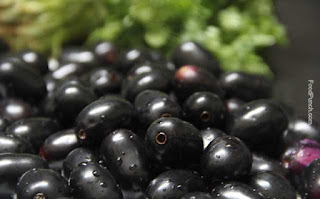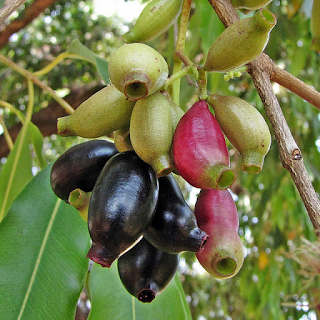 |
| Blackberry |
The blackberry is an edible fruit produced by many species in the Rubus genus in the Rosaceae family, hybrids among these species within the Rubus subgenus, and hybrids between the Rubus and Idaeobatus subgenera.
The taxonomy of the blackberries has historically been confused because of hybridization and apomixis, so that species have often been grouped together and called species aggregates.
For example, the entire subgenus Rubus has been called the Rubus fruticosus aggregate, although the species R. fruticosus is considered a synonym of R. plicatus.
 |
| Kalo Jam |
Blackberries are perennial plants which typically bear biennial stems ("canes") from the perennial root system.
In its first year, a new stem, the primocane, grows vigorously to its full length of 3–6 m (in some cases, up to 9 m), arching or trailing along the ground and bearing large palmately compound leaves with five or seven leaflets; it does not produce any flowers. In its second year, the cane becomes a floricane and the stem does not grow longer, but the lateral buds break to produce flowering laterals (which have smaller leaves with three or five leaflets). First- and second-year shoots usually have numerous short-curved, very sharp prickles that are often erroneously called thorns. These prickles can tear through denim with ease and make the plant very difficult to navigate around. Prickle-free cultivars have been developed. Recently the University of Arkansas has developed primocane fruiting blackberries that grow and flower on first-year growth much as the primocane-fruiting (also called fall bearing or everbearing) red raspberries do.
Unmanaged mature plants form a tangle of dense arching stems, the branches rooting from the node tip on many species when they reach the ground. Vigorous and growing rapidly in woods, scrub, hillsides, and hedgerows, blackberry shrubs tolerate poor soils, readily colonizing wasteland, ditches, and vacant lots.
The flowers are produced in late spring and early summer on short racemes on the tips of the flowering laterals. Each flower is about 2–3 cm in diameter with five white or pale pink petals.
The drupelets only develop around ovules that are fertilized by the male gamete from a pollen grain. The most likely cause of undeveloped ovules is inadequate pollinator visits. Even a small change in conditions, such as a rainy day or a day too hot for bees to work after early morning, can reduce the number of bee visits to the flower, thus reducing the quality of the fruit. Incomplete drupelet development can also be a symptom of exhausted reserves in the plant's roots or infection with a virus such as Raspberry bushy dwarf virus.
Ecology:
Blackberry
leaves are food for certain caterpillars; some grazing mammals, especially deer, are also very fond
of the leaves. Caterpillars of the concealer moth Alabonia geoffrella have been
found feeding inside dead blackberry shoots. When mature, the berries are eaten
and their seeds dispersed by several mammals, such as the red fox and the
Eurasian badger, as well as by small birds.
Blackberries grow wild
throughout most of Europe. They are an important element in the ecology of many
countries, and harvesting the berries is a popular pastime. However, the plants
are also considered a weed, sending down roots from branches that touch the
ground, and sending up suckers from the roots. In some parts of the world
without native blackberries, such as in Australia, Chile, New Zealand, and the
Pacific Northwest of North America, some blackberry species, particularly Rubus
armeniacus (Himalayan Blackberry) and Rubus laciniatus (Evergreen Blackberry),
are naturalised and considered an invasive species and a serious weed.
Blackberry fruit are red before they are ripe, leading to an old expression that "blackberries are red when they're green". In various parts of the United States, wild blackberries are sometimes called "Black-caps", a term more commonly used for black raspberries, Rubus occidentalis.
As there is forensic evidence from the Iron Age Haraldskær Woman that she consumed blackberries some 2500 years ago, it is reasonable to conclude that blackberries have been eaten by humans over thousands of years.
 |
| Boro Kalo Jam |
Blackberry fruit are red before they are ripe, leading to an old expression that "blackberries are red when they're green". In various parts of the United States, wild blackberries are sometimes called "Black-caps", a term more commonly used for black raspberries, Rubus occidentalis.
As there is forensic evidence from the Iron Age Haraldskær Woman that she consumed blackberries some 2500 years ago, it is reasonable to conclude that blackberries have been eaten by humans over thousands of years.
For more: Visit my other site

What a plonker, those are black currents not black berries! 👌😂🤲🏼
ReplyDelete